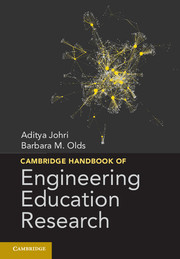Book contents
- Frontmatter
- Dedication
- Contents
- Editors
- Contributors
- Foreword
- Acknowledgments
- Introduction
- Chapter 1 Chronological and Ontological Development of Engineering Education as a Field of Scientific Inquiry
- Part 1 Engineering Thinking and Knowing
- Part 2 Engineering Learning Mechanisms and Approaches
- Part 3 Pathways into Diversity and Inclusiveness
- Chapter 14 Engineering Identity
- Chapter 15 Studying the Career Pathways of Engineers
- Chapter 16 Retention and Persistence of Women and Minorities Along the Engineering Pathway in the United States
- Chapter 17 Social Justice and Inclusion
- Chapter 18 Community Engagement in Engineering Education as a Way to Increase Inclusiveness
- Part 4 Engineering Education and Institutional Practices
- Part 5 Research Methods and Assessment
- Part 6 Cross-Cutting Issues and Perspectives
- Index
- References
Chapter 16 - Retention and Persistence of Women and Minorities Along the Engineering Pathway in the United States
Published online by Cambridge University Press: 05 February 2015
- Frontmatter
- Dedication
- Contents
- Editors
- Contributors
- Foreword
- Acknowledgments
- Introduction
- Chapter 1 Chronological and Ontological Development of Engineering Education as a Field of Scientific Inquiry
- Part 1 Engineering Thinking and Knowing
- Part 2 Engineering Learning Mechanisms and Approaches
- Part 3 Pathways into Diversity and Inclusiveness
- Chapter 14 Engineering Identity
- Chapter 15 Studying the Career Pathways of Engineers
- Chapter 16 Retention and Persistence of Women and Minorities Along the Engineering Pathway in the United States
- Chapter 17 Social Justice and Inclusion
- Chapter 18 Community Engagement in Engineering Education as a Way to Increase Inclusiveness
- Part 4 Engineering Education and Institutional Practices
- Part 5 Research Methods and Assessment
- Part 6 Cross-Cutting Issues and Perspectives
- Index
- References
Summary
Introduction
Countries around the world rely on the contributions of engineers to support national interests and maintain economic competitiveness. In the United States, government and industry leaders have long regarded engineers and other members of the science, technology, engineering, and mathematics (STEM) workforce as vital to the nation's economy and security. It is hardly surprising, then, that issues surrounding student retention and persistence in engineering degree programs and the engineering workforce are of special interest to engineering educators.
Since the 1970s, federal policy and funding have specifically focused on attracting and retaining women and minorities in science and engineering fields. Yet progress has been halting. In one comprehensive study, the United States ranked 30th of 35 countries in the proportion of female Ph.D.s in engineering, manufacturing, and construction, and 24th of 30 with respect to growth in the proportion of female Ph.D.s in these sectors (European Commission, 2009, p. 51). In this chapter, we examine the influence of U.S. federal policy on engineering education over the past forty years, with special attention to the impact of efforts to increase the number of women and minorities in the STEM workforce.
- Type
- Chapter
- Information
- Cambridge Handbook of Engineering Education Research , pp. 311 - 334Publisher: Cambridge University PressPrint publication year: 2014
References
- 100
- Cited by

